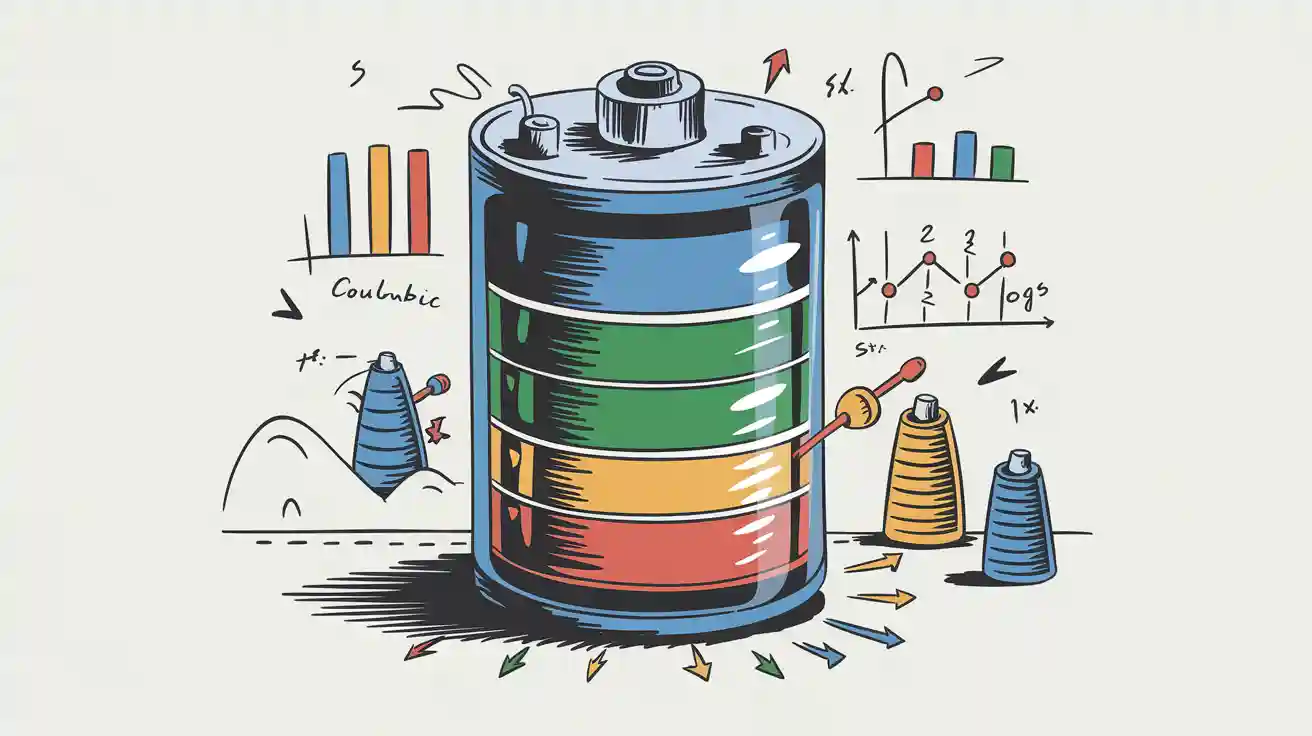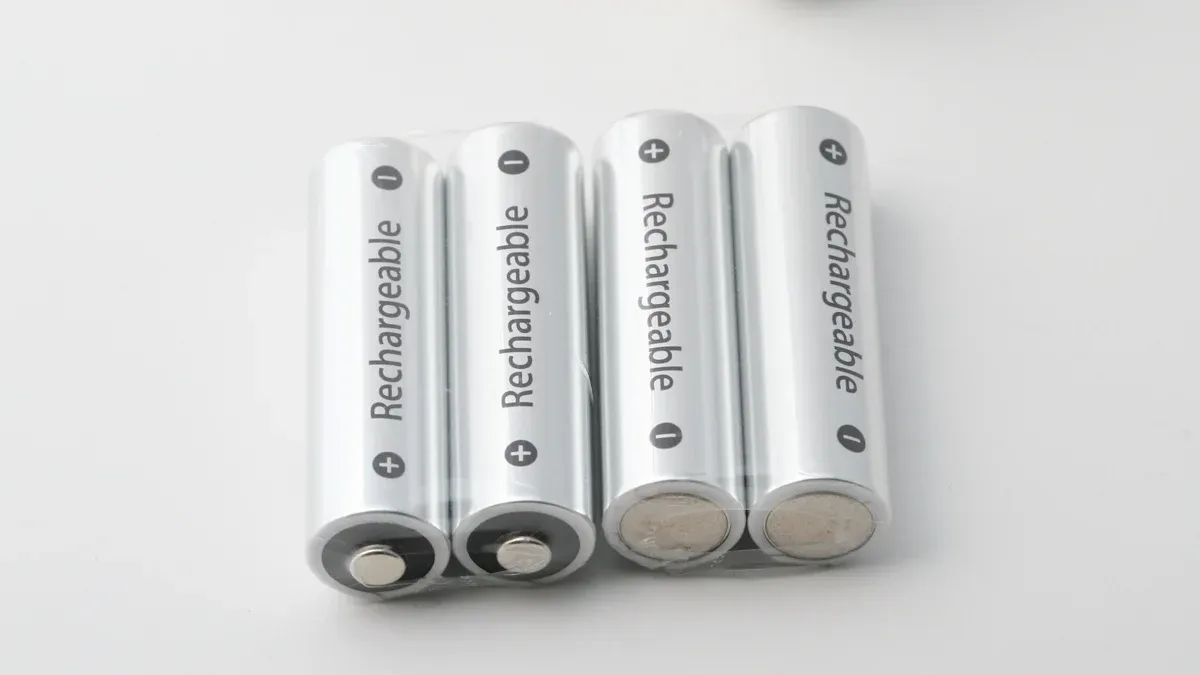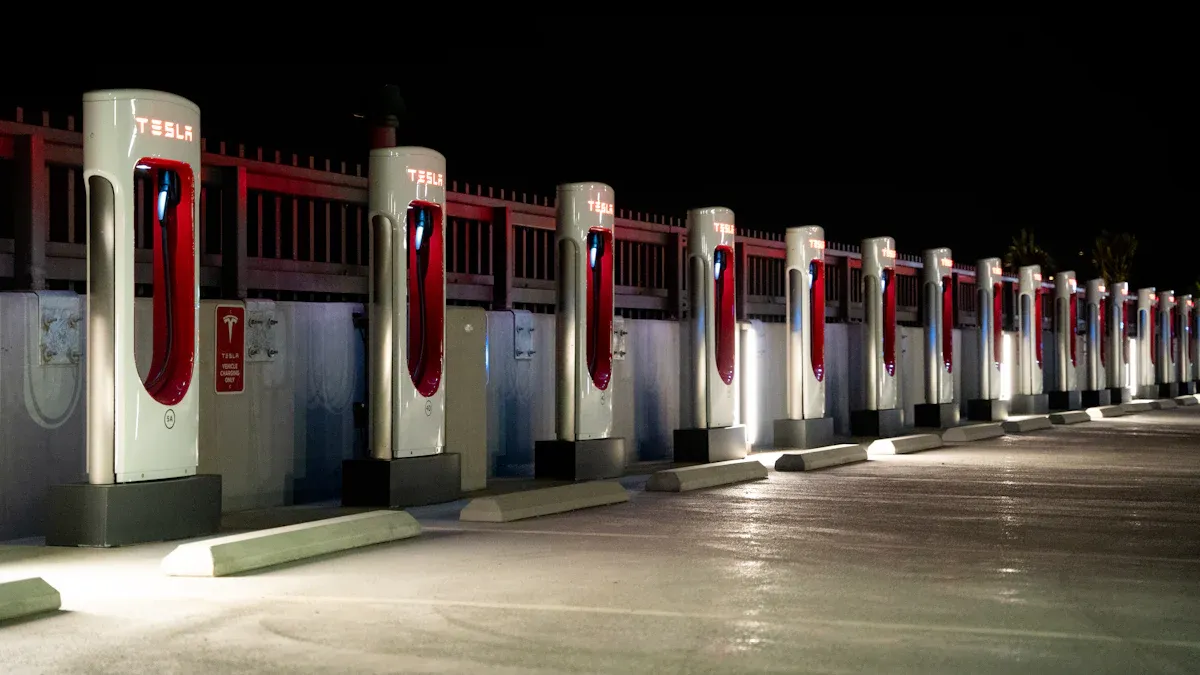
You need to understand coulombic and energy efficiency with the battery to optimize lithium battery efficiency in business-critical applications. Coulombic efficiency measures how much charge you retain during cycling, while energy efficiency factors in voltage losses, impacting usable output. See how small changes affect battery performance:
Coulombic Efficiency (CE) | Battery Cycle Life Impact | Capacity Retention |
|---|---|---|
Rapid decay after a few dozen cycles | Significant capacity loss | |
>99.99% CE | Maintains over 80% capacity after 800 cycles | High energy retention |
Coulombic and energy efficiency with the battery directly influence cycle life, cost, and operational reliability across batteries.
Key Takeaways
Coulombic efficiency measures how well a battery retains charge during use, while energy efficiency accounts for voltage losses and shows how much usable energy you get.
High coulombic and energy efficiency extend battery life, improve reliability, and reduce costs, especially in critical applications like medical devices and electric vehicles.
You can improve battery efficiency by controlling charge rates, managing temperature, using quality materials, and monitoring batteries with smart systems.
Part 1: Coulombic and Energy Efficiency with the Battery

1.1 Coulombic Efficiency
You need to understand coulombic efficiency to evaluate lithium battery efficiency in your battery packs. Coulombic efficiency represents the ratio of charge extracted from the battery during discharge to the charge supplied during charging, measured in ampere-hours (Ah). This metric tells you how effectively your battery stores and releases charge without loss to side reactions.
Tip: High coulombic efficiency means your battery loses less charge to unwanted chemical reactions, which directly impacts cycle life and reliability.
Experimental studies use high-precision current measurements during long-term cycling to validate typical coulombic efficiency values in lithium-ion battery systems. These tests show that coulombic efficiency usually approaches but does not reach 100%. Side reactions—such as lithium plating, electrolyte decomposition, and electrode changes—cause small but measurable losses. For example, when you operate batteries at higher temperatures or extreme states of charge, you see a drop in coulombic efficiency due to increased side reactions. Over time, these losses accumulate and lead to battery ageing.
You can measure electrochemical reversibility in lithium battery efficiency using several laboratory methods:
Potentiostatic charge/discharge tests
Electrochemical impedance spectroscopy (EIS)
Intermittent titration techniques
Stable voltage profiles and low, consistent impedance values in these tests indicate high reversibility and, therefore, high coulombic efficiency. When you see stable cycling voltage profiles and minimal impedance growth, your battery system maintains its performance over hundreds of cycles.
1.2 Energy Efficiency
Energy efficiency in lithium battery efficiency measures how much usable energy you get out compared to the energy you put in, expressed in watt-hours (Wh). This metric accounts for both charge losses and voltage losses due to internal resistance and polarization. You calculate lithium battery efficiency for energy by dividing the energy delivered during discharge by the energy supplied during charging.
Laboratory measurements assess voltage losses by tracking open-circuit voltage, resistance, and discharge voltage profiles. For example, you can use electrochemical impedance spectroscopy to separate and quantify resistance components that cause voltage drops. These voltage losses reduce the total usable energy, even if coulombic efficiency remains high.
Measurement Parameter | Description | Relation to Voltage Losses and Energy Efficiency |
|---|---|---|
Capacity | Total charge stored in the battery | Indicates stored energy but not direct voltage loss measurement |
Open-Circuit Voltage (OCV) | Voltage of battery with no current flow, representing max voltage | Baseline voltage reference, helps identify voltage drops |
Resistance | Degree to which materials impede current flow, causing voltage drop | Directly quantifies voltage losses affecting energy efficiency |
Measurement Methods | DC or AC methods used to measure resistance | Provides quantitative data on voltage losses during operation |
You will notice that energy efficiency always falls below coulombic efficiency because it includes both charge and voltage losses. For instance, a lithium-ion battery may show a coulombic efficiency above 99%, but its energy efficiency drops to about 97% at moderate charge rates and can fall further at higher rates due to increased internal resistance.
1.3 Key Differences
You must distinguish between coulombic and energy efficiency with the battery to make informed decisions about battery procurement and management. The table below summarizes the main differences and typical battery efficiency values for various battery chemistries:
Battery Type | Coulombic Efficiency (CE) | Energy Efficiency (%) | Notes on Conditions and Trends |
|---|---|---|---|
Lithium-ion (Li-ion) | >99% (improves with cycling, e.g., 99.1% to 99.9%) | ~99% at 0.05C charge rate; drops to ~97% at 0.5C; lower at 1C | CE highest among rechargeable batteries; affected by charge rate and temperature; Tesla Roadster energy efficiency ~86% |
Lead Acid | ~90% | N/A | Lower CE than Li-ion; varies with charge rate and temperature |
Nickel-based (NiCd, NiMH) | ~70-90% (depends on charge rate) | N/A | Fast charge ~90% CE; slow charge ~70% CE; affected by state-of-charge and temperature |
You see that lithium-ion batteries deliver the highest coulombic and energy efficiency with the battery, making them the preferred choice for industrial, infrastructure, and consumer electronics applications. In contrast, lead acid and nickel-based batteries show lower efficiency, especially under fast charging or extreme conditions.
Power Source | Efficiency Type | Efficiency Value |
|---|---|---|
Lithium-ion Battery | Coulombic Efficiency | ~99% |
Fuel Cell | Energy Efficiency | 20% to 60% |
Internal Combustion Engine (ICE) | Energy Efficiency | 25% to 30% |
GE90-115 Jet Engine | Energy Efficiency | 37% |
This comparison highlights that lithium battery efficiency in terms of coulombic efficiency far exceeds other power sources, while energy efficiency remains high but always slightly lower due to voltage losses.
Note: When you calculate lithium battery efficiency, always consider both coulombic and energy efficiency with the battery. High coulombic efficiency ensures minimal charge loss, while high energy efficiency guarantees more usable energy output for your application.
You should monitor both metrics to optimize battery performance, extend cycle life, and reduce operational costs. For business-critical applications—such as Medical, robotics, security, infrastructure, and industrial battery packs—these efficiencies determine reliability and total cost of ownership. If you want to explore custom solutions for your battery packs, consider our OEM/ODM consulting services.
Part 2: Improve Lithium Battery Efficiency

2.1 Factors Affecting Lithium Battery Efficiency
You need to understand the main factors that impact lithium battery efficiency in battery packs. These factors influence both coulombic and energy efficiency, affecting the performance of batteries in electric vehicles, Medical devices, robotics, security systems, infrastructure, consumer electronics, and industrial applications.
Charge Current: High charge current can reduce lifespan and capacity.
State of Charge (SoC): Accurate SoC measurement is critical for efficiency, especially at high temperatures.
Internal Resistance: Increases with battery age and chemistry changes, reducing performance.
Battery Temperature: High temperatures speed up aging and capacity loss. Charging below freezing can cause permanent damage.
Battery Age: Efficiency drops as batteries cycle and face environmental stress.
2.2 How to Improve Lithium Battery Efficiency
You can improve lithium battery efficiency by following proven strategies:
Charge wisely using chargers designed for your battery type and avoid overcharging.
Maintain batteries within optimal temperature ranges using advanced thermal management.
Optimize charging and discharging rates to reduce energy loss.
Use high energy density electrode materials and optimize electrolyte composition.
Inhibit side reactions through improved manufacturing and electrolyte formulations.
Integrate cells into modules to reduce internal resistance.
Employ intelligent Battery Management Systems (BMS) for real-time monitoring.
Perform regular maintenance, including cleaning terminals and testing capacity.
Battery Type | Energy Efficiency Range | Key Features and Applications |
|---|---|---|
90–95% | High efficiency, used in smartphones, laptops, electric vehicles | |
95–98% | Long cycle life, used in solar, electric buses | |
LTO | 85–90% | Exceptional safety, fast-charging applications |
Lead-Acid | 70–85% | Low efficiency, backup systems |
NiMH | 70–80% | Hybrid vehicles, household devices |
2.3 Practical Implications for Battery Packs
When you improve lithium battery efficiency, you extend cycle life and reduce operational costs. Efficient batteries deliver more cycles, which is critical for electric vehicles and energy storage systems. Advanced control methods, such as extremum seeking control, help optimize current and efficiency even under changing loads. Improved cooling and thermal management also maintain stability and extend battery life.
For custom solutions to maximize lithium battery efficiency in your battery packs, consult our OEM/ODM experts.
You see that monitoring both coulombic and energy efficiency in batteries reveals how cycling and rejuvenation steps affect performance. Case studies show that adjusting cycling conditions improves batteries’ efficiency. To maximize batteries’ service life, you should:
Control temperature and current in batteries.
Use machine learning to predict batteries’ aging.
Educate teams on batteries’ best practices.
Optimize batteries’ design and thermal management.
Regularly monitor batteries’ efficiency metrics.
FAQ
What is the main reason for efficiency loss in lithium batteries?
You see efficiency loss in lithium batteries mainly from internal resistance and side reactions. These factors reduce usable energy and shorten the service life of batteries.
How do you monitor efficiency in large-scale battery packs?
You use advanced sensors and data analytics to track charge, voltage, and temperature. Regular monitoring helps you optimize batteries for Medical, robotics, and industrial applications.
Why should you choose Large Power for custom battery solutions?
Large Power provides tailored consulting and design for batteries in demanding business environments. You can contact our experts for custom solutions.






